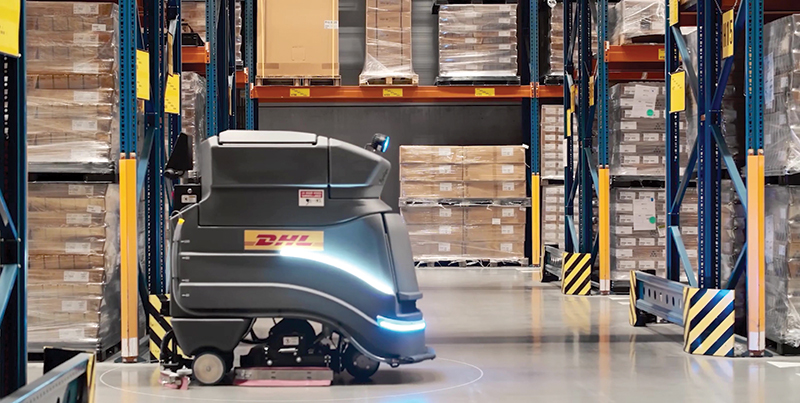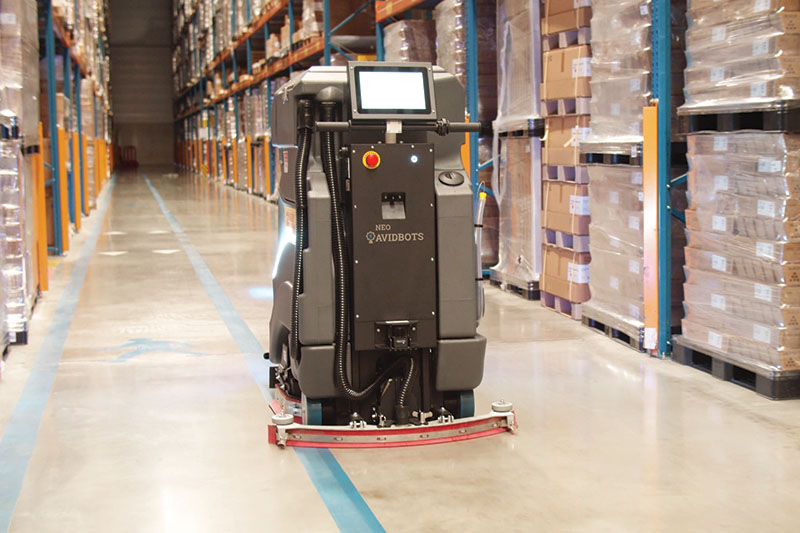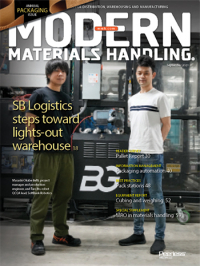Autonomous Cleaning Bots: Coming to your DHL neighborhood facility
From Alberta to Australia, DHL has moved to autonomous bots for cleaning the floors of its facilities of all sizes and levels of activity. It’s a story of advanced technology and collaboration to maximize floor cleanliness without compromising safety or efficiency.
“Go clean your room.”
There’s a memorable phrase we’ve all heard. And some of us reacted better to it than others.
Without revealing anything about their childhoods in a recent interview, both Greg Foreman and Bruce Anderson of DHL apparently reacted very well to that request many years ago.
As a result of their development efforts during the past three years, DHL now has autonomous bots cleaning more than 60 facilities from Alberta, Canada, to Florida. In addition, Avidbots, supplier of the autonomous floor scrubber, Neo, shipped the first bot to DHL Australia this summer.
A number of notable achievements are worth noting here. This is the first time DHL has used automation to clean its facilities. Not only that, but they went with autonomous bots. That’s a whole different level of leaning in to new technology.
While the initial effort was a bit of an experiment, it still had to meet established return on investment standards— less than three years. Furthermore, the inspiration for the project was not to reduce staff, but to find a more efficient way to clean facilities safely.
That’s quite a list for a project that Foreman, vice president of operations at DHL, initially thought “was really pretty cool.” That has translated into 65 total bots cleaning more than 150 million square feet. So far, the technology has saved 17,000 cleaning labor hours. Cool, indeed.
Making plans
Anderson has long been known at DHL for his interest in using new technology. Anderson is general manager of operations of Connect Logistics, a wholly owned DHL subsidiary with four facilities in Alberta, Canada. Little did he know what was coming his way.
Foreman shared that it is a DHL strategic priority to bring new technology into DHL facilities across the globe. “Our five-year plan calls for the company to be a material and strategic investor in technology across many functions in our facilities,” explains Foreman.
Early research identified floor cleaning as an area ripe for technology. The internal review team agreed, making the decision to go with the most advanced technology available: autonomous bots.
That first step led to a review of potential strategic partners who supplied the technology. Several were considered.
“This is a two-step process,” explains Foreman. One is a philosophical approach to working with a strategic partner, and the other is technology based.
On the philosophy side of the ledger, Foreman says DHL looked for a supplier “with a good reputation, a high degree of responsiveness and a strong relationship builder.” Then comes the evaluation of technical capabilities with no small emphasis on a good match of the technology to DHL’s needs, continues Foreman.
As executive sponsor of the project, Foreman gave Anderson a call about doing a pilot project with the bots.

The pilot
The initial approach was to take a small bite. The pilot, which started in late 2018, focused on a single bot in a single facility with a minimum of floor traffic. The objective was to completely clean the 250,000-square-foot facility twice a week.
Getting there took about two months. During that time, Anderson was not entirely on his own. Initial support came from both Foreman and the corporate review team that had established the project, and, of course, the supplier. There was a heavy emphasis on collaboration.
Jeff Schrantz, vice president of global sales and marketing at Avidbots, says being a strategic partner was as important to his company as it was to DHL.
“We needed to work with an end user that did not sugar coat its evaluation of the technology and its effectiveness.”
Not only did that relationship result in wide use of the Neo robots internationally at DHL today, but it was directly responsible for much of the technology advances since the start up in Alberta in the fall of 2018, says Schrantz.
If you’re thinking the Avidbots’ Neo is just a glorified Roomba vacuum for your home, think again.
To begin, the Neo is about the size of an automatic guided vehicle (AGV), roughly 5 feet long by 3 feet wide by 4.5 feet tall. But unlike most AGVs, onboard guidance entirely directs movement of the bot. The core technology here is Lidar, light detection and ranging. Lidar maps the facility with particular attention to obstacles, allowing the bot to travel autonomously.
The bot’s on-board artificial intelligence platform uses multiple sensors to react to objects in its path from walls to people and pallets. Meanwhile, it continues cleaning the floor, running for up to 6 hours continuously on a single battery charge. At any time, the Neo can be switched over to manual operation if needed.
It’s one thing to understand the safety of this technology, but it also requires some work with staff to fully appreciate its capabilities, explains Anderson. That meant the pilot included several startup meetings with staff.
“We needed people to realize and accept that the bot was no danger to them. It was safe. It wasn’t going to take their jobs. And they could coexist out on the floor,” recalls Anderson. “It all went over very well. We’ve never had a safety incident,” he adds.
One of the points of emphasis was the improvement of the facility’s internal environment. While most people in maintenance agree that a clean floor is a sign of a well-run operation, the Neo also helps to improve air cleanliness, too. “We emphasized that bots actually create a cleaner, healthier environment that could reduce potential respiratory issues,” says Anderson.
Building out from the base
Today, all four of the Connect Logistics facilities in Alberta use the Neo. The largest of the facilities at 500,000 square feet requires two bots to provide two complete cleans a week. The smaller facilities require only a single bot, says Anderson. Getting there he calls a progression.
Each bot runs roughly two and a half shifts a day with the opportunity to clean more as needed. At the start of that cycle, an operator starts the machine(s) after determining the sequence of zones to clean based on expected facility activity that day.
Each bot has a cleaning goal for the day, explains Anderson. During that half shift of inactivity, the bot’s onboard water is drained and the batteries charged. “It’s actually pretty straight-forward operation,” says Anderson.
He does point out that mapping is important, particularly as it relates to determining the best times of day to clean a particular section of concrete.
While startup of the first pilot was in the fall of 2018, all four were up and running by early 2019. “It only took about two months to get each facility up and running,” says Anderson. And soon after that startup, Foreman says the technology was rolled out to several other facilities following the general template of the first install.
Foreman says the bots are used in the full range of DHL facilities. That includes what he calls “pretty busy warehouses.” The profile of those is 1 million square feet, more than 350 associates, 200 pieces of materials handling equipment, and three shift operation six and half days a week.
In each rollout, says Foreman, there was strong coordination between the corporate team and the local facilities. Typically, the corporate team identifies what it thinks is a strong candidate facility. “It then notifies the facility that autonomous bots are coming to their neighborhood,” says Foreman.
However, there were instances, he says, when the local team was not ready for the technology and had veto power over its implementation at that particular time. “That’s just another example of the collaboration involved in this project,” he adds.
Also worth mentioning, says Foreman, is that the bots are not for every facility. “A two-person facility of only 50,000 square feet is not a good use of the technology,” he adds.
Meanwhile, the technology itself changed. The bots are now known as the Neo 2.
Perhaps most importantly, the AI platform has new algorithms. These provide 360-degree visibility that allows the bot to see all of its surroundings and more easily manage dynamic environments. These advances also improve real-time obstacle avoidance and dynamic path planning.
Another advance is what is called an active cleaning system. Now, the cleaning head adjusts automatically as the pitch of the floor changes or the head wears down, providing consistent cleaning intensity.
In addition, safety lights have been added. These include a beacon light, front headlights and brake lights. Neo can also talk to you to improve operating efficiencies and further enhance safe operation.
All involved with the project say continuous improvement remains standard procedure. In fact, Avidbots and DHL still have a monthly call to review and update each other on progress and new opportunities for further collaboration.
“As far as we’re all concerned, it’s a major accomplishment to have autonomous cleaners that can work safely in our busy facilities,” says Anderson. “We’re quite proud of what we’ve done.”

Article Topics
MRO News & Resources
Avidbots showcases autonomous cleaning robots Traka exhibits modular lockers MRO Survey: Finding and keeping the best technicians Maintenance, Repair and Operations: Understanding the true condition of the equipment Newly formed Bison combines AMETEK DFS and Bison Gear and Engineering Corp. Building (and maintaining) your maintenance, repair and operations (MRO) tech workforce The power side of lift truck battery and charger maintenance More MROLatest in Materials Handling
Registration open for Pack Expo International 2024 Walmart chooses Swisslog AS/RS and software for third milk processing facility NetLogistik partners with Vuzix subsidiary Moviynt to offer mobility solutions for warehouses Materials Handling Robotics: The new world of heterogeneous robotic integration BSLBATT is looking for new distributors and resellers worldwide Lucas Watson appointed CSO for Körber’s Parcel Logistics business in North America Hyster recognizes Dealers of Distinction for 2023 More Materials HandlingAbout the Author
Subscribe to Materials Handling Magazine

Find out what the world's most innovative companies are doing to improve productivity in their plants and distribution centers.
Start your FREE subscription today.
April 2024 Modern Materials Handling

Latest Resources












